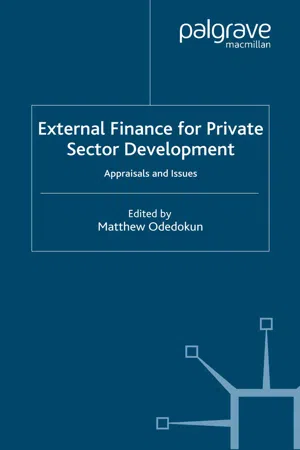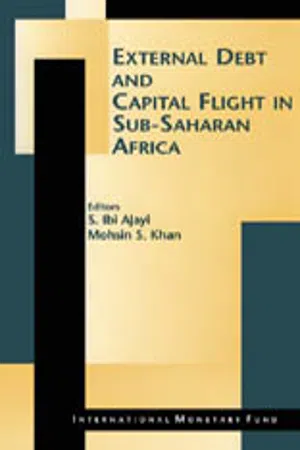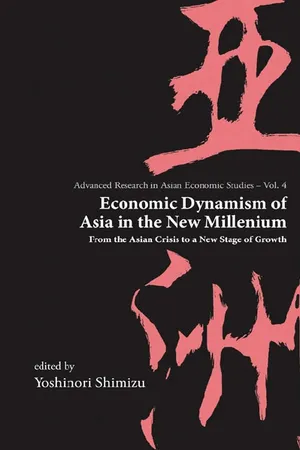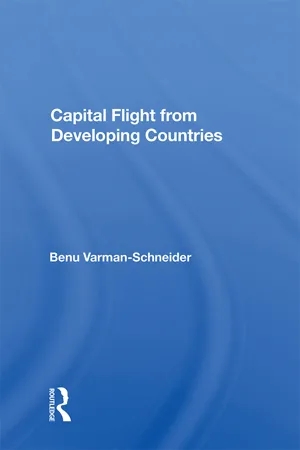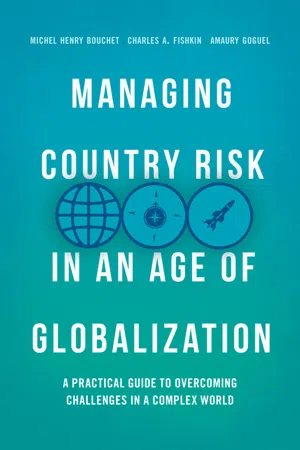Economics
Capital Flight
Capital flight refers to the large-scale exit of financial assets and capital from a country due to economic or political instability. This can lead to a decrease in investment and economic growth within the country experiencing the flight. It often occurs when investors lose confidence in the domestic economy and seek more stable and profitable opportunities abroad.
Written by Perlego with AI-assistance
Related key terms
1 of 5
8 Key excerpts on "Capital Flight"
- eBook - PDF
External Finance for Private Sector Development
Appraisals and Issues
- M. Odedokun(Author)
- 2004(Publication Date)
- Palgrave Macmillan(Publisher)
In their view, the phenomenon of Capital Flight is somehow related to the existence of extremely high uncertainty and risk with respect to returns on domestically held assets. Residents take their money and run in order to avoid extremely high losses on their domestic asset holdings. Authors like Deppler and Williamson (1987) argue that Capital Flight is motivated by the fear of losing wealth due to, for example, expropriation of wealth by the gov- ernment, sudden exchange rate depreciation, non-repayment of government debts (changes in) capital controls and financial market regulations, and 208 Niels Hermes, Robert Lensink and Victor Murinde (changes in) tax policies. Walter (1987) and Kindleberger (1987) have a similar opinion. These authors suggest that Capital Flight should be related to the abnormal or illegal nature of certain capital outflows. Yet, in practice it is extremely difficult to empirically distinguish between normal and abnor- mal or illegal capital outflows (see also Gordon and Levine 1989). Therefore, several authors argue that Capital Flight should not be distinguished from normal capital outflows (see, for example, Erbe 1985; World Bank 1985; Morgan Guaranty 1986, 1988). It is argued that for countries struggling with (large) current account deficits and external debt payments – and which are thus in need of foreign capital – any capital outflow increases the problems of financing their net imports and debt payments. The measurement of Capital Flight is not straightforward, given that there is no consensus on the definition of Capital Flight. Indeed, several Capital Flight measures are available in the literature. Not surprisingly, this leads to differences in Capital Flight estimates for different countries. - INTERNATIONAL MONETARY FUND(Author)
- 2000(Publication Date)
- INTERNATIONAL MONETARY FUND(Publisher)
This chapter first reviews the various definitions and the implied measures of Capital Flight in the literature and then attempts to estimate Capital Flight from Uganda using those definitions and measures that can be applied within the constraints of the available data. In addition, it investigates the causes and consequences of Capital Flight out of Uganda during 1971–94. The chapter also reviews the theoretical explanations of Capital Flight in the literature. This is followed by a discussion of developments in the Ugandan economy, particularly those that suggest the likelihood of Capital Flight. Estimates of Capital Flight from Uganda are also reported. The chapter then discusses the significance of capital outflows from Uganda, as well as the results of some tests of hypotheses about Capital Flight with Ugandan data. The chapter concludes with a summary of the findings and their policy implications.Passage contains an image
Definitions, Measurement, and Causes of Capital Flight
Definitions and Measurement of Capital Flight
The recent literature on Capital Flight recognizes the diversity of definitions and related measures of the phenomenon (Khan and Ul Haque, 1985 ; Ajayi, 1990 ; Pastor, 1990 ; and Ng’eno, 1992 ). The question “what is Capital Flight?” leads to different concepts and measurements. Some analysts prefer a narrow definition of Capital Flight as a short-term speculative outflow of funds, which Cuddington (1986) identifies as the prototypical form of Capital Flight. Others define Capital Flight as all outflows of capital that represent that part of a country’s total wealth that is not available for servicing a country’s external debt or for development financing because residents acquire assets abroad (Khan and Ul Haque, 1985 ; and Chang and Cumby, 1991 ).The variety of definitions of Capital Flight arises because in a world of varying country-specific risks, optimal portfolio selection rules suggest that rational agents prefer assets with low risk and high returns in an attempt to protect the value of their wealth. Thus, if the risk of holding a domestic asset is high in a developing country, owners will prefer to hold foreign rather than domestic assets. Hence, the outflow of capital from developing to developed countries would be the normal response. Thus, it has been suggested that the term Capital Flight is a “pejorative description of natural, economically rational responses to the portfolio choices that have confronted wealthy residents of some debtor countries in recent years” (Lessard and Williamson, 1987- eBook - PDF
Economic Dynamism Of Asia In The New Millennium
From the Asian Crisis to a New Stage of Growth
- Yoshinori Shimizu(Author)
- 2007(Publication Date)
- World Scientific(Publisher)
4.1. Literature Review The study of Capital Flight came into attention of international financial economists after the birth of the financial crisis in Latin America in 1980s. The study has since become popular, especially when countries or regions experienced major financial and currency crises. Cuddington (1987) studies the determinants of Capital Flight in four Latin American countries, which are Mexico, Argentina, Uruguay and Venezuela, facing the most severe problems of Capital Flight during the economic crisis in Latin America. The sources for his study were from the annual balance of payment reported by the International Monetary Fund (IMF), covering the period of 1974-1984. This annual data, however, was regarded as too Determinants of Asian Capital Flight and the Impact of 1997 Economic Crisis 11 limit (the data can not be appropriately collected on a quarterly basis in this period of time) and might result in the unreliable findings. The results of Cuddington (1987) show that there are three factors that can explain the Capital Flight from the four countries, though some of them might have different levels of significance. Firstly, the Exchange Rate Overvaluation, with positive relation, can describe the Capital Flight from the four selected countries. This implies that the states should impose the macroeconomic policy which does not allow the overvaluation of local currency, as it motivates people to move their capital to other countries with more stable currencies. Secondly, an increase in the interest rates in the United States, with positive relation, can describe the Capital Flight in Mexico and Venezuela. Thus, the fact that the industrialized countries, specifically the United States, implements proper macroeconomic policy can help lessening the problems of Capital Flight in the developing countries. Lastly, capital inflows in the form of foreign loans can positively describe the Capital Flight in Mexico and Uruguay. - eBook - ePub
- Benu Varman-Schneider(Author)
- 2019(Publication Date)
- Routledge(Publisher)
The measuring procedure used to estimate the magnitude of Capital Flight represents a departure from the earlier approaches to measurement in that the motivation factors are explicitly incorporated in the measuring technique. A simple regression model to estimate the magnitude of Capital Flight in the period 1971-85 was utilised. The results show that both political and economic factors interacted to stimulate massive outflows of capital. The estimates obtained tally with the range of Capital Flight estimates in various newspaper reports.Earlier studies cite many factors to explain Capital Flight from the Philippines such as overvalued exchange rates, high and variable rates of inflation, budget deficits, unsatisfactory economic performance, regressive taxation and risk. An accompanying obvious motivation for Capital Flight from the Philippines was the existence of political risk in the country not captured by earlier studies. The term political risk generally connotes government expropriation of non-resident investments in international markets. Political risk can, as seen in recent history, be a feature of activities among the government and citizens within a given jurisdiction. In the Philippines, the political risk consisted in the weak or non-existent system of checks and balances on a wide range of actions and decisions by the Marcos regime, and the limited liability enjoyed by the bureaucrats evident in the political and economic crisis years starting from 1983 through 1984. The declaration of martial law in 1972 set into motion a political process leading to a system of government where the president could exercise legislative power indefinitely by invoking extraordinary executive powers under conditions of martial law. Later, a constitutional amendment made such power permanent. In addition, restrictions on freedom of press and information, the climate of fear engendered by the prominent role of the military, and the imprisonment of many political leaders effectively weakened the process of a democratic political system. In a democracy, the objective function of the government can be defined as improving the welfare of the people. Failure to accomplish at least some minimum desired level may endanger the chances of a political party to remain in power. The state of affairs in the Philippines in the Marcos era signaled the weakening of the operation of the democratic process. The objective function defined in terms of the welfare of the people was replaced by a more avaricious self-interest motivated one, the appropriation of domestic output and foreign capital. The principles of economics, however, operated in the political sphere as well. Monopoly in political power led to waste and inefficiency. Bureaucrats were not governed by considerations of the nation's welfare, but by concern of their own private welfare. The late 1970s and early 1980s were a period of unsound economic policies and blatant political interferences into the working of a market economy. These are evidenced by the shift of government capital outlays away from infra-structure projects towards other capital outlays, intervention in the financial sector and the move away from conservative monetary and fiscal policies. Government regulation was also evidenced by the introduction of government-mandated monopolies in the sugar and coconut industry. The increase in monopoly power led to external debt levels being negotiated beyond the debt repayment capacity of the country followed by Capital Flight by the authorities in power. This was made possible by the elimination of the need for legislative scrutiny and approval, the prevalence of which might presumably have reflected the taxpayers' concern more closely. In fact, we can explicitly define the desired objective function of the government beginning in 1972 as appropriation of national wealth which became possible in a system devoid of checks and balances. What might appear as government waste and inefficiency turned out to be gain and profit for private interests of a selected group of people in power. The next three sub-sections examine the influence of the political institution, as it existed in the Philippines before the onset of the crisis, on economic decision-making. - eBook - ePub
Managing Country Risk in an Age of Globalization
A Practical Guide to Overcoming Challenges in a Complex World
- Michel Henry Bouchet, Charles A. Fishkin, Amaury Goguel(Authors)
- 2018(Publication Date)
- Palgrave Macmillan(Publisher)
capital outflows .To test this positive combination, we analyze four countries that have received large capital inflows since the early 1980, both with foreign direct investment and portfolio flows: two in Latin America (Chile and Mexico) and two in East Asia (Indonesia and Philippines). We examine how the extent of financial liberalization and structural reforms has encouraged capital flows while limiting or even reversing Capital Flight in these after a period of economic, financial, and political crisis. Figure 14.5 provides a measure of expatriated private bank deposits in percentage of each country’s GDP. The right axis shows Chile’s moderate amounts of capital outflows that remained at roughly 0.2% of GDP between 1990 and 2014, after a sharp decline in 1986–1989. The striking increase in Capital Flight in Indonesia during the 1997–1998 crisis was followed by a gradual decline. Mexico shows two clear increases in Capital Flight . The first rise took place during the debt crisis of mid-1980s that led to a successful debt reduction. The second took place during the so-called “tequila crisis” of 1994 that led to a sharp depreciation of the currency, as discussed later. Finally, in the case of the Philippines, Fig. 14.5 shows relatively moderate Capital Flight at the equivalent of 1% of GDP, after large outflows in the 1970s and mid-1980s.Fig. 14.5The ups and downs of Capital Flight (in % of GDP) 1984–2014(Sources Bank for International Settlements 2017 and World Bank 2017 - No longer available |Learn more
- José De Gregorio(Author)
- 2013(Publication Date)
99 5 Capital Flows Policymakers and researchers have a keen interest in capital inflows and how to manage them. However, the ways in which the data are viewed in popular discussions are often incomplete and sometimes misleading. Capital flows affect the economy from many angles. And, like many economic issues, they have a nontrivial ideological content. In the economic sphere, capital flows are relevant to financial stability, macroeconomic fluctuations, and exchange rates. An important distinction should be made, however, between gross and net capital inflows, which have different implications for macroeconomic manage-ment and financial stability. Exchange rate pressures are associated with net rather than gross capital flows. By contrast, financial stability is much more associated with gross flows because the volume of flows—as well as their com-position—is relevant to the vulnerabilities of the financial system, in particular the banking industry. Indeed, in distinguishing between price stability and financial stability in central banking, in general, price stability has to do with low and stable inflation and a smooth business cycle (in short, macroeconomic stability) and financial stability with low vulnerabilities in the financial system. Therefore, in the area of capital flows macroeconomic stability has to do with net flows, whereas financial stability has to do with gross flows. 1 But first an obvious clarification: Capital account opening is welfare enhancing, but it has risks that, when not appropriately managed, may end up incurring costs that outweigh the benefits. Just like trade in goods and services, intertemporal trade is beneficial. Capital-scarce countries can finance valuable 1. For further discussion, see CIEPR (2012). 100 HOW LATIN AMERICA WEATHERED THE GLOBAL FINANCIAL CRISIS investment and anticipate consumption, just as young households do in the domestic economy. - eBook - ePub
Financial Stability and Central Banks
A Global Perspective
- Richard Brearley, Juliette Healey, Peter J N Sinclair, Charles Goodhart, David T. Llewellyn, Chang Shu(Authors)
- 2001(Publication Date)
- Routledge(Publisher)
Yielding to the pressure on the exchange rate implies depreciation. The home prices of imported goods and exportable goods are bid up. Although this threat to inflation is essentially only one-off, and depends on what caused the capital flow, exactly how it is distributed over time is hard to tell in advance. The magnitude and speed of exchange rate pass through to the domestic price level vary country by country and, within countries, over time as well. Pass through is more rapid when labour markets are tight, and apt to be bigger in smaller countries, with large ratios of trade to national income. Inflation targets are overshot, possibly by large margins. Exchange rate depreciation is particularly uncomfortable when the domestic private (or public) sector has large debts denominated in foreign currency, as is highly likely for developing countries. Then there is the risk, so well exemplified by Thailand in 1997, of an explosion of worries about the quality of bank loans and the solvency of the domestic banks themselves. This can only lead to positive feedback on the capital account of the balance of payments. Domestic and foreign actors scramble to transfer still more funds abroad, unless the exchange rate collapses so far that all market participants agree that it can hardly drop any further.In sum, international capital outflows can be highly disruptive to both monetary and financial stability. The central bank has to opt between the macroeconomic downturn frequently induced by a successful defence of the exchange rate, on the one hand, and the perils of a burst of inflation, possibly exacerbated by solvency problems, when it acquiesces in an exchange rate slide on the other. Neither prospect entices.Small wonder, then, that the case for taxing, restricting or discouraging international capital movements is often viewed sympathetically by the central banking community. The sheer scale of international capital movements in contemporary conditions is bewildering; and, following widespread liberalization, they appear to be growing much faster than central banks’ foreign exchange reserves. Given the undoubted and increasingly serious threats they imply for financial and monetary stability, nostalgia for the quieter times of earlier decades is all too understandable.7.2.2 The gains from international capital movements
It is well to remember, however, that international capital movements can be a blessing, too. For one thing, the current account of the balance of payments may be volatile, and accommodating private capital flows, often engineered by interest rate decisions enacted by the central bank, provide an invaluable method—often really the only - eBook - PDF
Pursued Economy
Understanding and Overcoming the Challenging New Realities for Advanced Economies
- Richard C. Koo(Author)
- 2022(Publication Date)
- Wiley(Publisher)
bond holdings. Today, the potential for investors to move preemptively—correctly or otherwise—is far greater than it was 30 years ago given the prev- alence of quick-acting hedge funds and computer-driven program trading. If the U.S. administration wants to adopt a weak-dollar pol- icy, it therefore needs to assume there will be a certain amount of Capital Flight. In other words, the United States should not have to worry about the trilemma previously noted because it is a deficit country trying to weaken its own currency, but it must be careful to ensure that Capital Flight out of the dollar—and the rise in domestic interest rates that would result—does not get totally out of control. Two Types of “Equalizing” Capital Flows and the Quality of Investors The impact of capital flows on exchange rates also depends on the qual- ity of the investors involved as well as whether those flows are being driven by direct investment or portfolio investment. Although most of the preceding discussion on capital flows assumes that they consist mostly of portfolio flows, direct investment flows from nonfinancial corpora- tions also generate cross-border capital flows. Such flows are becoming increasingly important as businesses in pursued countries seek higher returns on capital by investing in emerging countries. The distinction between direct and portfolio investment is impor- tant because even though both “equalize” returns on capital across national borders, their impact on exchange rates can be quite differ- ent. Most investors who are sending money abroad in the form of 6 Asahi Shimbun (1988), “Endaka ‘Seiho-Hannin-Setsu’ ni Kyokai ga Irei no Hanron” (“Accusation that Life Insurers Are Responsible for Strong Yen Is Absurd”), in Japanese, March 30, 1988, p. 9.
Index pages curate the most relevant extracts from our library of academic textbooks. They’ve been created using an in-house natural language model (NLM), each adding context and meaning to key research topics.
